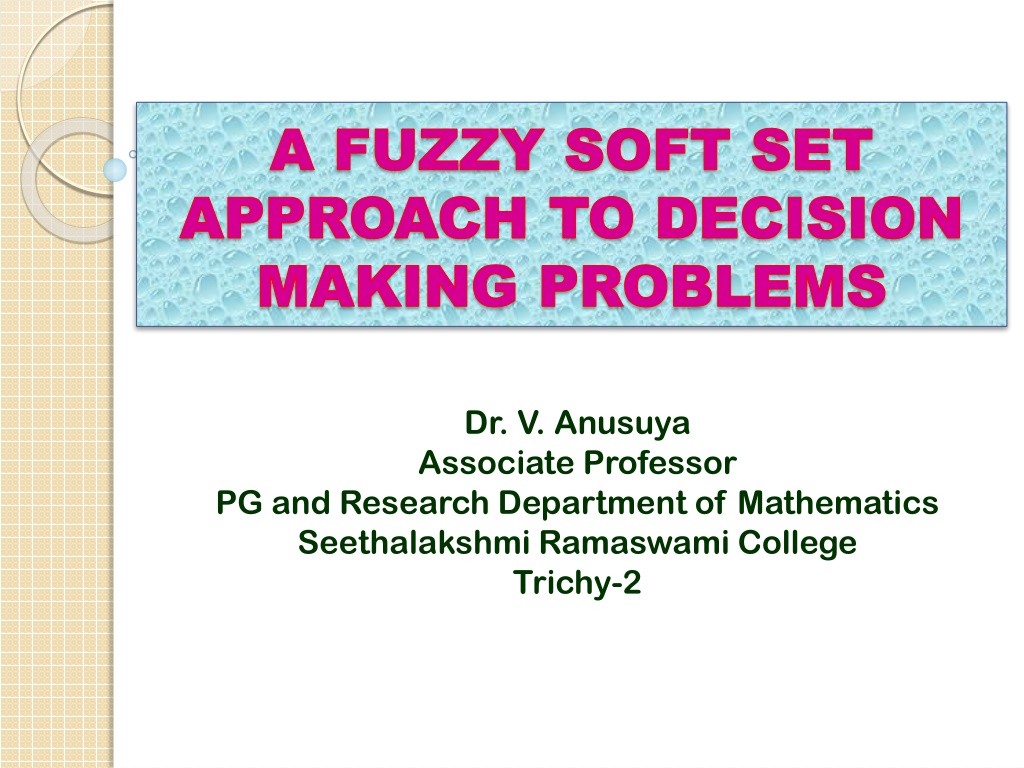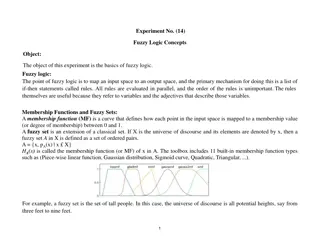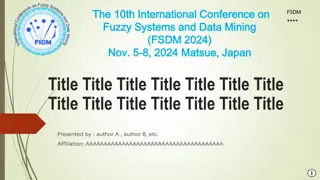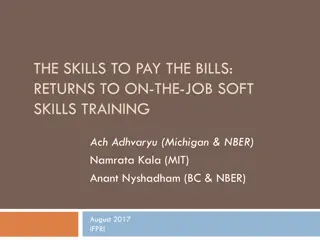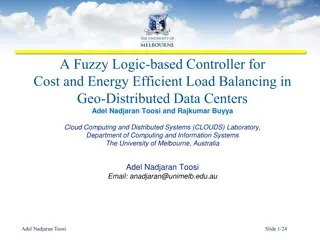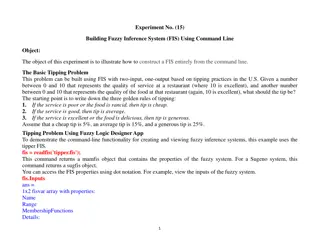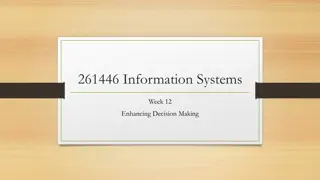Understanding Fuzzy Soft Set Approach to Decision Making Problems
Real-life problems often involve imprecise data, requiring mathematical principles like fuzzy set theory. Dr. V. Anusuya explores the application of fuzzy soft sets in decision making scenarios, discussing their role in handling uncertainties and approximations. The introduction covers various theories such as probability, fuzzy sets, intuitionistic fuzzy sets, and interval mathematics. Soft set theory emerges as a tool to address the limitations of fuzzy sets, offering a parametrized approach to describing objects with predicate and approximate value components. Examples illustrate the concepts, showcasing the transition from fuzzy sets to soft sets. Applications in various fields like engineering, social sciences, and economics highlight the versatility of fuzzy soft set approach.
Download Presentation

Please find below an Image/Link to download the presentation.
The content on the website is provided AS IS for your information and personal use only. It may not be sold, licensed, or shared on other websites without obtaining consent from the author. Download presentation by click this link. If you encounter any issues during the download, it is possible that the publisher has removed the file from their server.
E N D
Presentation Transcript
A FUZZY SOFT SET APPROACH TO DECISION MAKING PROBLEMS Dr. V. Anusuya Associate Professor PG and Research Department of Mathematics Seethalakshmi Ramaswami College Trichy-2
INTRODUCTION: Most of our real life problems in engineering, social and medical sciences, economics, environment etc involve imprecise data and their solutions involve the use of Mathematical principles, based on uncertainty and imprecision to handle such uncertainties, a number of theories have been proposed. Some of these are, 1) Probability 2) Fuzzy sets 3) Intutionistic fuzzy sets 4) Interval Mathematics and rough sets
Fuzzy set was developed by L.A. Zadeh in 1965. It is an attempt to deal with the problems of uncertainties. Fuzzy set: A fuzzy set A, over U is a set defined by a function representing a 1 , 0 : U A A u U A mapping . ( ) u Here is called the membership function of X, and the value is called A the grade of membership of , represents the degree of u belonging to the fuzzy set X. Thus a fuzzy set X over U can be represented as follows: ( ) ( ) : / = u u u A A ( ) u , 1 , 0 U A Example: ( 2 . 0 ) ( , ) ( , ) ( , ) ( , ) A = / 0 / 3 . 0 / 1 / 8 . 0 / x x x x x Let 1 2 3 4 5 ix Where is an element of the reference set E. E- Fuzzy set.
Why we have Soft set? One of the deficiencies of fuzzy set theory is how to set the membership function. Given the various observations on the efficiency of the existing tools for solving uncertainty problems, soft set theory emerged to soften these limitations. Soft set is a parametrized general mathematical tool which deel with a collection of approximate descriptions of objects. Appropriate description has two parts, 1) Predicate 2) Approximate value
Soft set: denotes the power set of U. A pair (F, E) is called a soft set over a given universal set U, if and only if F is a mapping of a set of parameters E, in to the power set of U. That is , . Clearly, a soft set over U is a parametrized family of subsets of a given universe U. Also for any F(e) is considered as the set of e- approximate element of the soft set (F, E). Example: 1). Let A be a fuzzy set and be the membership function of the fuzzy set , that is, is a mapping of U into [0,1], let be a family of level sets for function .If the family F is known, can be found by means of the definition ( ) ( ) 0,1 , x F Let U be the universal set and let E be a set of parameters. Let P(U) ( ) P U : F E , e E A / A ( ) ( ) x = x U , 0,1 F A ( ) Ax A = sup x A Hence every fuzzy set A may be considered as the soft set (F, [0,1]).
Let be the set of Cars under 1 2 3 4 5 6 7 , , , , , , , , U C C C C C C C C C C = 2). , 8 9 10 consideration, E be a set of parameters. e E e = = = = = exp automaticgear e , , lg = , , ensive e beautiful e ingoodrepair e = manua ear e inbadrepair cheep 1 2 3 4 = , , 5 6 7 The the soft set (F, E) describes the attractiveness of the cars. Applications of Soft set Theory: Game Theory Operations Research Riemann integration Probability theory
1999- D.A.Molodtsov - Soft set theory 2002- Maji et al - Decision making problem 2009- A. Sezgin & A.O.Atagun- Demorgan s law 2010- K.V.Babitha & J.J.Sunil - Soft set relation, partition 2010- N.Cagmann & S.Enginoglu - Soft matrices 2011- M.A.Ozturk & E.Inan - Various operations in soft set and its properties 2012- D.K.Sut - Fuzzy soft relations and also applied to decision making problems
Fuzzy Soft Set: denote the power set of all fuzzy subsets of U. Let A E. A pair (F , E) is called a fuzzy soft set over U, where F is a mapping given by : F A I U Let U be an initial universal set and let E be a set of parameters. Let I U Example: Suppose a fuzzy soft set (F, E) describes the attractiveness of the shirts with respect to given parameters, which the authors are going to wear. Let which is the set of all shirts under consideration. Let be the collection of all fuzzy subsets of U. Also let I 1 2 , E e colorful e bright e = = = = , , , , U x x x x x 1 U 2 3 4 5 = = , , cheep e warm 3 4 x x x x x x x x x x ( ) 1 ( ) 1 Let 3 5 3 5 1 2 4 1 2 4 = = , , , , , , , , F e F e 0.5 0.9 0 0 0 1.0 0.8 0.7 0 0 x x x x x ( ) 1 x x x x x 3 5 1 2 4 = , , , , ( ) 1 F e 3 5 1 2 4 = , , , , F e 0 1.0 0 0 0.3 0 0 0 0.6 0 Then the family of is a fuzzy soft set (F,E). ( ) , 1,2,3,4 F e i = U I
Definition : (F,A) (G,B) is defined by (F,A) (G,B) = (H,A B), where Definition :. If (F,A) and (G,B) be two soft sets then (F,A) OR (G,B) denoted by (F,A) (G,B) is defined by (F,A) (G,B) = (O,A B), where ( ) ( ) , O F G = Example: Consider two fuzzy-soft-sets (F,A) and (G,B) over the same universal set . Here U represents the set of houses, A = {blackish, reddish, green} and B = {blackish, reddish, green, large}, and F (blackish) = F (reddish) = F (green) = G (blackish) = G (reddish) = G (green) = G (large) = 1 2 3 0.4, 0.6, h h h If (F,A) and (G,B) be two soft sets then (F,A) AND (G,B) denoted by ( ) ( ) ( ) = A B , , H F G ( ) A B , = , , , , U h h h h h 1 2 3 4 5 0.4, 1, 0.5, 0.4, 1, 0.6, 0.6, h 0.6, 0.7, 0.5, h 0.8, 0.6, h 0.9, 0.9, 0.8, h 0.8, 0.9, h 0.8, 0.8, 1 h h h h h h h h h h 1 1 1 1 1 1 2 0.5, h h 0.6, h 3 0.5, h h 0.5, h 4 1, h h 1, h h 5 0.7 h h 1 h h h 2 3 4 5 0.7 1 2 2 3 3 4 4 5 5 h h 2 3 4 5 0.6, 1 1 2 3 4 5 4 5 Clearly, (F,A) (G,B).
Algorithm: 1. Input the fuzzy soft sets (F, A), (G,B) and (H,C). 2. Input the parameter set P as observed by the observer. 3. Compute the corresponding resultant fuzzy soft set (S, P) from the fuzzy soft sets (F, A), (G,B), (H,C) and place it in tabular form. 4. Construct the Comparison table of the fuzzy soft set (S, P) and compute and for , i. 5. Compute the score of , i. 6. The decision is if, . 7. If k has more than one value then any one of may be chosen. Application in a decision making problem: Let , be the set of objects having different colours, sizes and surface texture features. The parameter set, E={blackish, dark brown, yellowish, reddish, large, small, very small, average, very large, course, moderately course, fine, extra fine}. Let A,B and C denote three subsets of the set of parameters E. ir io it io S k S = max S k i k o = , , , , , U o o o o o o 1 2 3 4 5 6
Also let A represent the colour space and B represents the size of the object. A = {blackish, dark brown, yellowish, reddish}, B = {large, very large, small, very small, average}. The subset C represents the surface texture granularity . C ={course, moderately course, fine, extra fine}. Assuming that the fuzzy soft sets (F,A) describe the objects having colour space, (G,B) describes the objects having size and (H,C) describes the texture feature of the object surface. The problem is to identify an unknown object from the multiobservers fuzzy data, specified by different observers, in terms of fuzzy soft sets (F, A), (G,B) and (H,C), as specified earlier. These fuzzy soft sets may be computed as below. The fuzzy-soft-set (F,A) is defined as
(F,A)={objects having blackish colour , objects having dark brown colour , objects having yellowish colour 1 2 3 4 0.6, 0.3, 0.8, 0.4, o o o o = = 0.3, 0.3, 0.4, 0.8, 0.7, 0.9 o o o o o o 1 2 3 4 5 6 = 0.4, 0.9, 0.5, 0.2, 0.3, 0.2 o o o o o o 1 2 3 4 5 6 , 0.6, 0.4 o o 5 6 objects having reddish colour 1 2 0.9, o o = }. 0.5, 0.7, 0.8, 0.5, 0.3 o o o o 3 4 5 6 U O1 o2 o3 o4 o5 O6 blackish = a1 dark brown = a2 yellowish = a3 reddish = a4 0.3 0.4 0.3 0.9 0.4 0.5 0.8 0.2 0.7 0.3 0.9 0.2 0.6 0.3 0.8 0.4 0.6 0.4 0.9 0.5 0.7 0.8 0.5 0.3
The fuzzy-soft-set (G,B) is U large = b1 very large = b2 small = b3 very small = b4 average = b5 O1 0.4 0.2 0.8 o2 0.8 0.6 0.3 o3 0.6 0.4 0.4 o4 0.9 0.8 0.2 o5 0.2 0.1 0.9 o6 0.3 0.2 0.8 0.6 0.1 0.1 0.1 0.8 0.6 0.5 0.7 0.7 0.4 0.7 0.5 The fuzzy-soft-set (H,C) is U course = c1 moderately course = c2 fine = c3 extra fine = c4 O1 0.3 0.4 O2 0.6 0.5 O3 0.5 0.6 o4 0.7 0.6 o5 0.6 0.6 o6 0.8 0.7 0.1 0.4 0.3 0.6 0.5 0.7 0.9 0.5 0.6 0.3 0.4 0.9
Let (F,A) and (G,B) be any two fuzzy-soft-sets over the common universe U. After performing some operations (like AND, OR etc.) on the fuzzy- soft-sets for some particular parameters of A and B, we obtain another fuzzy-soft- set. The newly obtained fuzzy-soft-set is termed as resultant-fuzzy-soft-set of (F,A) and (G,B). Considering the above two fuzzy-soft-sets (F,A) and (G,B) if we perform (F,A) AND (G,B) then we will have 4 5 = 20 parameters of the form , where , for all i = 1, 2, 3, 4 and j = 1, 2, 3, 4, 5. If we require the fuzzy soft set for the parameters , then the resultant fuzzy soft set for the fuzzy soft sets (F,A) and (G,B) will be (K,R), say. So, after performing the (F,A) AND (G,B) for some parameters the tabular representation of the resultant fuzzy soft set will take the form as ij e = e a b ij i j = , , , , , , R 11 e 15 e e e e e e 21 24 33 44 45 U O1 o2 o3 o4 o5 o6 e11 0.3 0.3 0.4 0.8 0.2 0.3 e15 0.3 0.3 0.4 0.4 0.7 0.5 e21 0.4 0.8 0.5 0.2 0.2 0.2 e24 0.4 0.1 0.1 0.1 0.3 0.2 e33 0.6 0.3 0.4 0.2 0.6 0.4 e44 0.6 0.1 0.1 0.1 0.5 0.3 e45 0.5 0.5 0.7 0.4 0.5 0.3
Let us now see how the algorithm may be used to solve our original problem. Consider the fuzzy soft sets (F, A), (G,B) and (H,C) as defined above. Suppose that , , , , 11 e e c e c e c e c e c 1 15 3 c e 21 2 c 24 4 = P , , 33 3 44 3 45 4 be the set of choice parameters of an observer. On the basis of this parameter we have to take the decision from the availability set U. The tabular representation of resultant fuzzy soft set (S, P) will be as 15 e o o o o o o U 11 e c c e c e c 33 e c e c e c 1 3 21 2 24 4 3 44 3 45 4 0.3 0.1 0.4 0.4 0.1 0.1 0.5 1 0.3 0.3 0.5 0.1 0.3 0.1 0.5 2 0.4 0.3 0.5 0.1 0.3 0.1 0.6 3 0.7 0.4 0.2 0.1 0.2 0.1 0.3 4 0.2 0.5 0.2 0.3 0.5 0.5 0.4 5 0.3 0.5 0.2 0.2 0.4 0.3 0.3 6
The Comparison table of the above resultant fuzzy soft set is as below. Table 1 1o 2 o 3 o o 5 o o 4 6 1o o 3 o o 5 o o 7 6 6 4 3 4 4 7 7 4 4 5 2 5 7 4 4 4 4 5 5 7 6 6 4 3 3 2 7 3 4 3 2 3 3 6 7 4 6 io Next we compute the row sum, column sum, and the score for each as shown below: Table 2 Row sum (ri ) column sum (ti ) 25 30 29 31 31 26 24 33 30 22 29 26 From the above score table, it is clear that the maximum score is 8, scored by and the decision is in favour of selecting . 5 o Score (Si ) 5 2 5 9 8 3 o1 o 3 o o 5 o 2 4 o 6 5 o
